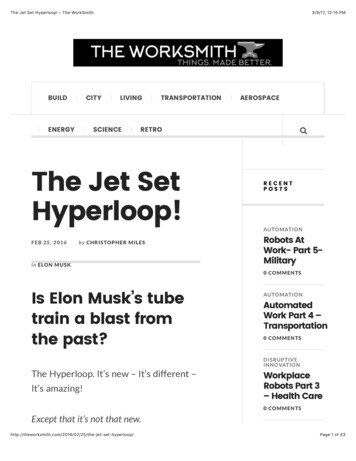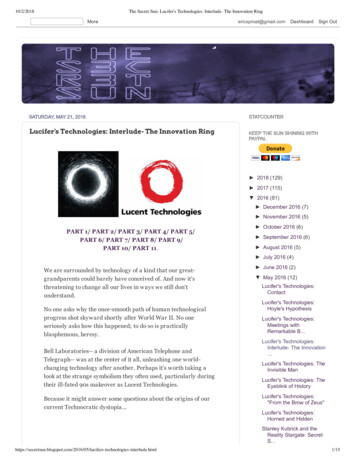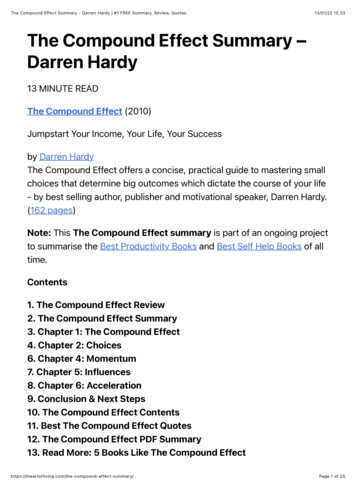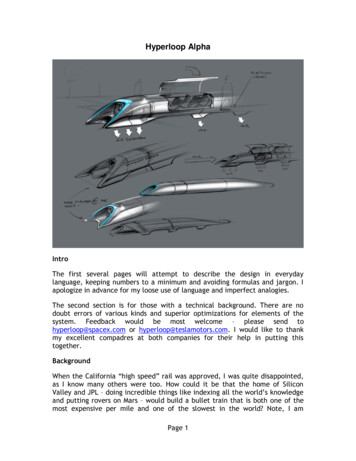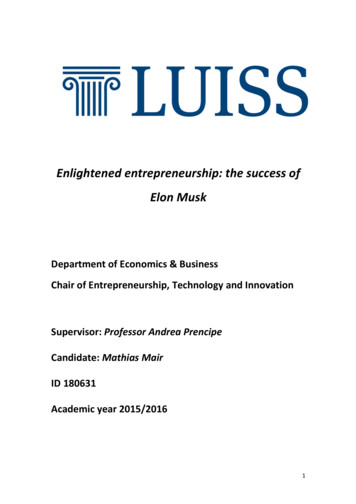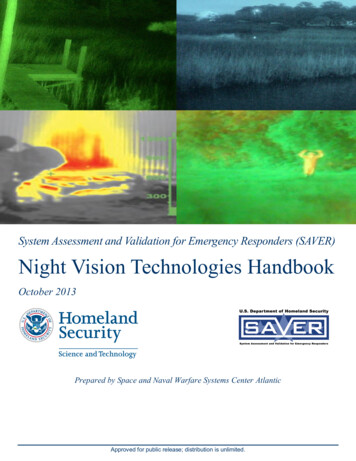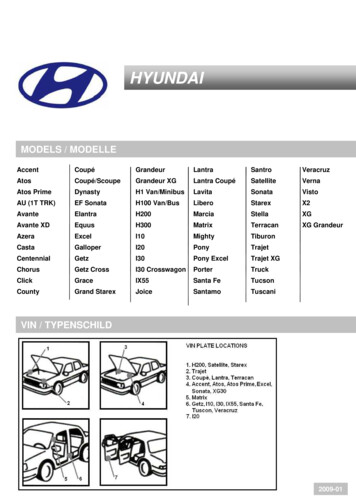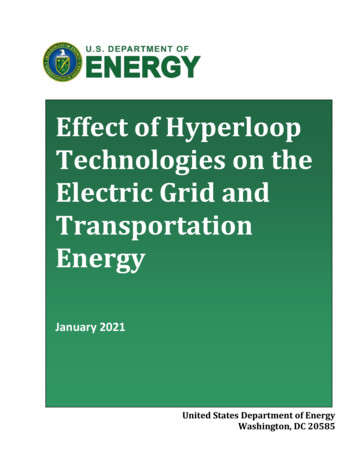
Transcription
Effect of HyperloopTechnologies on theElectric Grid andTransportationEnergyJanuary 2021United States Department of EnergyWashington, DC 20585
Department of Energy January 2021DisclaimerThis report was prepared as an account of work sponsored by an agency of the United Statesgovernment. Neither the United States government nor any agency thereof, nor any of theiremployees, makes any warranty, express or implied, or assumes any legal liability orresponsibility for the accuracy, completeness, or usefulness of any information, apparatus,product, or process disclosed or represents that its use would not infringe privately ownedrights. Reference herein to any specific commercial product, process, or service by trade name,trademark, manufacturer, or otherwise does not necessarily constitute or imply itsendorsement, recommendation, or favoring by the United States government or any agencythereof. The views and opinions of authors expressed herein do not necessarily state or reflectthose of the United States government or any agency thereof.
Department of Energy January 2021[ This page is intentionally left blank]Effect of Hyperloop Technologies on Electric Grid and Transportation Energy Page i
Department of Energy January 2021Executive SummaryHyperloop technology, initially proposed in 2013 as an innovative means for intermediaterange or intercity travel, is now being developed by several companies. Proponents point topotential benefits for both passenger travel and freight transport, including time-savings,convenience, quality of service and, in some cases, increased energy efficiency. Because thesystem is powered by electricity, its interface with the grid may require strategies that includeenergy storage. The added infrastructure, in some cases, may present opportunities for gridwide system benefits from integrating hyperloop systems with variable energy resources.DOE’s analysis of potential grid and energy efficiency impacts is based on conceptual data, asdrawn from open sources or made available by developers, and on transportation energy usedata. DOE relied, additionally, on studies of hyperloop systems by the National Aeronautics andSpace Administration, Volpe Transportation Center, and U.S. Department of Transportation.Modeling of grid impacts was carried out by DOE’s Pacific Northwest National Laboratory,utilizing electrical grid representations in three areas of the United States.Consistent with information found in concept papers, DOE’s analysis assumed that a typicaltravel distance for a hyperloop system would lie within an “intercity” range, that is, between100 to 1,000 miles. Data indicate that energy use in the intercity market represents about 30percent of total transportation energy use in the United States.Potential Effects on the Electric GridDOE’s modeling found that the energy and power demands of an operational hyperloop systemwould be significant. The electrical energy required to support one moderately sized hyperloopsystem over a 24-hour period might be in the range of 500 to 600 MWh/day for passengertravel; and up to 1,900 MWh/day for heavier freight. Peak power demand might be in the rangeof 100 to 600 MW for passenger systems and up to 2,000 MW for heavier freight systems.While the amount of energy required would be significant, it would likely fall within theoperational capacities of most power generating and transmission networks. For hyperloopsystems connected directly to the grid, however, the fluctuating power dynamics could presentserious challenges for grid integration. DOE modeling found that the power factor, magnitude,short duration, frequency, and number of power pulses per day, both from the grid (for podlaunch and acceleration) and back to the grid (during periods of regenerative braking), wouldinduce unusual stresses throughout the grid. These stresses, if sustained over time, wouldadversely impact electrical generating and transmission equipment, power quality, and longterm system maintenance and reliability, with implications for regional grid stability. Suchimpacts would need to be mitigated by buffering technology or by alternative designs. DOE isaware of innovative designs and technologies that address these issues (see Section II).Effect of Hyperloop Technologies on Electric Grid and Transportation Energy Page ii
Department of Energy January 2021Potential Effects on Transportation Energy DemandDOE’s analysis found that hyperloop transport of passengers, in selected cases, could saveenergy by up to 20 percent, compared to passenger travel by other modes, such as air orpersonal travel in light duty vehicles, as measured in terms of energy used per passenger-mile,and when compared to the average fleet efficiency projected to 2030. Such energy savingswould be less, if compared to today’s “best in class” vehicles, or to a future fleet with highervehicle utilization (i.e., passengers/vehicle) factors.DOE considered a hypothetical case of one 300-mile hyperloop passenger system, carrying15,000 passengers per day, which derived its travel demand by modal shift from a mix of air,rail, and road traffic. The annual energy savings were estimated to be about 2.8 trillion Btu in2030, or about 0.01 percent of national transportation energy demand.The extent to which such savings might be scalable from one exemplar system to a nationalnetwork, however, would depend on hyperloop’s ability to deploy widely and capturesignificant shares of its respective markets. DOE’s analysis assumed varying levels of intercitynetwork penetration from 1 system up to 1,000 systems, with hypothetical energy savingsestimates. Passenger travel in the intercity range of 100 to 1,000 miles is limited. Some intercityroutes exhibit high traffic volumes and others much less. Energy savings on a national scalewould be expected to be proportionate to the extent of deployment, which may itself belimited by intercity travel volumes. Alternatively, if such systems were able to create significantadded or induced travel demand, overall energy system use might increase, not decrease.The analysis shows that hyperloop transport of freight would be less energy-efficient per tonmile shipped than all other modes of freight transport, except for air. In the case of heavierfreight transport, DOE estimates that hyperloop systems would be at least 8 times less energyefficient than transport by water and rail, in terms of energy used per ton-mile shipped; and atleast 3 times less energy-efficient than transport by truck. In the case of lighter freight, such asby air, energy savings from modal shift would be limited by the total energy used for air freighttraveling in the intercity range, which is estimated to be less than 50 trillion BTU per year, orless than 0.5 percent of national transportation energy use. Scenarios that allocate all forms ofhigher-value freight to hyperloop, however, including non-air modes of shipping, such as bytruck, indicate an increase in energy use of around 1 percent of total transportation energydemand, due to loss of energy efficiency per-ton-mile compared to shipment by trucks.Apart from energy, hyperloop literature suggests that an array of potential benefits may berealized from fully operational hyperloop systems for passenger travel and shipping of freight.These may include economic benefits, environmental factors, reduced congestion, timesavings, grid complementarities, or induced demand. This analysis focused on energy and thegrid. No overall net benefit calculation was attempted.Effect of Hyperloop Technologies on Electric Grid and Transportation Energy Page iii
Department of Energy January 2021Acronyms and NASANERCPJMpuquadRMRGTBtuSTATCOMUAEVARWECCBritish Thermal UnitDepartment of EnergyEastern InterconnectU.S. Energy Information AdministrationElectric Reliability Council of TexasGravitational acceleration rate (9.8 meters/second/second)GigawattHyperloop Transportation TechnologiesHertzKilovoltMiles per HourMega volt ampMegawattMegawatt-hourNational Aeronautics and Space AdministrationNorth American Electric Reliability CorporationRegional transmission organization that coordinates movement of wholesaleelectricity in all of parts of Delaware, Illinois, Indiana, Kentucky, Maryland,Michigan, New Jersey, North Carolina, Ohio, Pennsylvania, Tennessee, Virginia,West Virginia and the District of Columbiaper unit (dimensionless)Quadrillion (1015) BtuRocky Mountain Reserve GroupTrillion (1012) BtuStatic synchronous compensatorUnited Arab EmiratesVolt-ampere reactiveWestern Electricity Coordinating CouncilEffect of Hyperloop Technologies on Electric Grid and Transportation Energy Page iv
Department of Energy January 2021EFFECT OF HYPERLOOP TECHNOLOGIES ONELECTRIC GRID AND TRANSPORTATION ENERGYTable of ContentsAcronyms and Abbreviations . ivI.Purpose of Report . 1III.Hyperloop Impact on the Electricity Grid . 11II.IV.V.What is Hyperloop? . 1Hyperloop Impact on Transportation Energy Use . 24Analysis Methodology (APPENDIX) . 36Effect of Hyperloop Technologies on Electric Grid and Transportation Energy Page v
Department of Energy January 2021I.Purpose of ReportIn 2018, motivated in part by growing interest in advanced and novel approaches to intercitytransportation modes, the U.S. Department of Energy undertook a study of the energy-relatedaspects of “hyperloop transportation systems”. Such systems are seen as having the potentialto increase the energy efficiency of the Nation’s transportation system.The study was framed to: (a) model the demands on the electric grid, and the overall energyconsumption of the transportation sector, of varying levels of network penetration of aninterconnected hyperloop system; (b) include information about how these systems could beintegrated into the electric grid; and (c) identify any technological constraints of the grid thatmust be addressed to allow the broad adoption of hyperloop technologies. This report lays outthe assumptions, methodologies and quantitative results of the research, modeling and analysisand summarizes the study’s major findings.II. What is Hyperloop?The term “hyperloop” is applied broadly to a category of fixed-guideway surface transportationsystems that use capsules or “pods” that travel at high speeds (potentially nearing the speed ofsound) in a sealed tube at partial ornear-complete vacuum. 1 Mostconceptual designs envision the use ofmagnetic levitation for lifting andguiding the pods and linear electricmotors for acceleration and braking.Such concepts eliminate the need forrails and wheels, except near stationsand stops, and minimize energy lossesdue to air resistance, heat and friction.Such a hyperloop concept is beingFigure 1. Broad Hyperloop Concept (Energetics)offered as a convenient, faster andpotentially more energy-efficientmeans of travel or freight transport than existing modes of air, rail, or road transport. Ittypically focuses on connecting pairs of cities, as shown conceptually in Figure 1, but couldapply to intracity movement, such as to and from a downtown location to an airport or beexpanded to a regional network of transportation guideways.1“Hyperloop Commercial Feasibility Analysis: High Level Overview,” U.S. Department of Transportation, 2016,https://rosap.ntl.bts.gov/view/dot/12308. Air pressure inside the tube could be as low as 1/100th atmosphere.Effect of Hyperloop Technologies on Electric Grid and Transportation Energy Page 1
Department of Energy January 2021Hyperloop HistoryThe basic concept of evacuated tube-based transportation is not new. An initial prototype ofsuch a system was demonstrated at Tomsk Polytechnic University in 1909. 2,3 Robert Goddard,well-known as a pioneer in rocket design and by extension space exploration, proposed andpatented a concept with features like those of the hyperloop concept. It involved a tunnelguideway evacuated by vacuum pumps and vehicles levitated by magnets. 4Modern researchers continue to work on “evacuated tube transport technologies,” genericallynoted as “ET3.” Although not studied here, some are targeting international travel systems thatmight travel over 4,000 miles per hour. 5Public interest in such systems was renewed in 2013with the publication of a concept paper by Elon Muskthrough SpaceX. 6 Known generally as “Hyperloop Alpha,”the paper presented an overview of the modernincarnation of the Goddard concept. It is a transportsystem based on modestly-sized pods, each with acarrying capacity of 20-30 passengers, driven by linearelectric motors and traveling in a steel tube that hasbeen mostly evacuated of air by vacuum pumps. Thepaper also introduced some of the major challengesfacing widespread implementation of such a system. Aninitial design sketch of the passenger pod from this 2013paper is shown in Figure 2.Figure 2. Initial SpaceX Concept forHyperloop Pod (SpaceX, 2013)After the 2013 concept paper, SpaceX sponsored a series of competitions to “support thedevelopment of functional prototypes and encourage innovation by challenging student teamsto design and build the best high-speed Pod.” 7 Several teams competed in these events anddemonstrated speeds of up to 290 miles per hour for small-scale pods. 82B. Weinberg, [Motion without friction. pre-α] (in Russian), 1914.Weinberg, Boris. “Five Hundred Miles an Hour.” Popular Science Monthly, 1917. 20monthly%201919.pdf.3Goddard, Esther C. Vacuum tube transportation system. United States US2511979A, filed May 21, 1945, and issued June 20, en.45Oster, Daryl, Masayuki Kumada, and Yaoping Zhang. “Evacuated Tube Transport Technologies (ET3): A Maximum Value Global TransportationNetwork for Passengers and Cargo.” Journal of Modern Transportation 19, no. 1 (March 2011): 42–50. https://doi.org/10.1007/BF03325739.6Hyperloop Alpha concept paper, SpaceX, 2013, https://www.spacex.com/hyperloopalpha.7SpaceX Hyperloop website, 2018, https://www.spacex.com/hyperloop.“Students from Germany win third SpaceX Hyperloop Pod Competition,” Washington Post, July 23, p-pod-competition/.8Effect of Hyperloop Technologies on Electric Grid and Transportation Energy Page 2
Department of Energy January 2021Potential Benefits of Hyperloop TechnologyAs broadly proposed, a main benefit of hyperloop transportation would be to enable faster,safer, more convenient, more energy efficient, and potentially cheaper transit between twopoints, as compared to existing modes of transport. If such systems were to capture asignificant share of the transport market, they might also alleviate congestion on roads, railsand in the air.Several factors are projected to allow hyperloop technology to increase convenience andreduce travel times between pairs of cities. A key factor is the high speed enabled by thesystem design – speeds of up to 700 miles per hour during cruise. This is much faster thanautomotive or rail systems, and rivals or exceeds air travel speeds. Another factor is locationand ease of access. An ideal hyperloop system is envisioned to board locally and conveniently,to reduce travel time relative to air travel by eliminating or greatly reducing time spent at eitherend of the journey. This would include traveling to and from a point of embarkation, such as anairport, waiting for a plane to push back, taxi and takeoff, land, and other delays. Also, ahyperloop system may provide flexible, timely, and demand-based departure scheduling.Hyperloop proponents also propose to limit the number of intermediate stops between theorigin and destination. This offers another opportunity for time savings relative to other surfacemodes of transport such as high-speed rail. The original Hyperloop Alpha concept paperenvisioned time savings as being the greatest for city pairs that are separated by 900 miles orless. 9 The paper suggested that in the future supersonic air travel (at higher speeds thancurrent commercial air travel) might be more time-efficient for distances beyond 900 miles.Depending on the logistics of ticketing and passenger/luggage transfers, there may also beother time savings. 10Convenience is another potential benefit for hyperloop passengers. As described, passengerhyperloop systems would dispatch modestly-sized pods of 20-30 people with relatively highfrequency, that is, with a pod launched every two minutes or less. 11 Compared to a high-speedtrain, with its rail cars all connected, hyperloop systems also have flexibility to move pods incohorts like rail, or independently by routing them along the way to multiple destinations.As alluded to earlier, an ancillary urban benefit, if there were to be significant use of hyperloopsystems for intercity travel, might be reduced traffic congestion by reducing trips made byprivate vehicles on interconnecting highways, bypass roadways, and circumferential beltwaysbetween and around cities. Frequent hyperloop service might also attract travel from shorter9SpaceX, 2013.10SpaceX, 2013.Average headway for the New York City subway system is between 2.5 and 3 minutes according to 2017 data from the National TransitDatabase.11Effect of Hyperloop Technologies on Electric Grid and Transportation Energy Page 3
Department of Energy January 2021regional airline flights, thus relieving pressure on hub airports where it is expected that travelvolume will increase in the future. 12Hyperloop technology is also envisioned to achieve improved energy efficiency compared toconventional modes of transport. Aerodynamic losses associated with pod travel will be lowercompared to other modes because of the evacuated tube (with low air pressure and resultinglow air resistance). Each pod may be able to coast with little additional power for a significantportion of the overall length of the trip. Energy input to pod motion will be required for initialacceleration and for periodic speed boosts during cruise. Regenerative braking, however, maycapture a significant portion of the pod’s kinetic energy at the end of each trip. If captured andstored, such energy could be re-used within the system or transferred to the grid for useelsewhere.Depending on application and design, there may be other system-wide energy benefits. Thepower needed to run the vacuum pumps and some portion of the pod transport could besupplied by distributed energy resources, reducing demand for power from the electricity grid.Reductions in energy use from increased efficiency and the substitution of electricity forpropulsion for petroleum-based fuels for cars, trucks, buses, rail and air, could result in reducedreliance on oil imports and in reduced emissions of criteria air pollutants and greenhouse gases.The latter would depend on the emissions profile of the electricity generating sources providingthe power.DOE review of concepts did not include economic analysis of various hyperloop systemproposals. For added context, some potential economic benefits for hyperloop riders are notedhere, as proffered by proponents. Some estimate that ticket prices for hyperloop transportwould be relatively low. The Hyperloop Alpha concept paper estimated ticket prices of 20 for aone-way ticket between Los Angeles and San Francisco. 13 Such a ticket price would depend onseveral factors, many of which are uncertain. These include, among other things, the cost offinancing, the costs of rights-of-way and construction per mile, the extent of tunneling versussurface or elevated guideways, the anticipated passenger volume, size of the pod fleet andfrequency of pod departures, the continued development of advanced technology, includingthat required to sustain high vacuum along the long route and the potential for, if any,offsetting public financial support.Hyperloop developers have also suggested the system could serve as a competitive alternativeto traditional freight transportation modes of air, truck, or rail. Reduced travel time, lower cost,and increased schedule flexibility could attract shippers of high-value or time-sensitive freight.Schafer, Andreas, and David G Victor. “The Future Mobility of the World Population.” Transportation Research Part A: Policy and Practice 34,no. 3 (April 1, 2000): 171–205. SpaceX, 2013.Effect of Hyperloop Technologies on Electric Grid and Transportation Energy Page 4
Department of Energy January 2021Challenges with Hyperloop TechnologyAlthough there are several potential benefits of hyperloop systems, there are challenges aswell. In addition to those noted above, these include pod manufacturing and purchasing ofsupporting equipment at scale; costs are largely unknown and could be potentially high. TheHyperloop Alpha authors estimated costs of around 16 million per mile for a passengersystem. Others have estimated costs of 25-27 million per mile. 14 By comparison, the cost of arural, undivided, 2-lane paved road typically costs around 2-4 million per mile. 15 The estimatedcost of the California high-speed rail plan was recently revised to nearly 150 million per mile. 16Hyperloop costs would be dependent on whether the transport tubes are built above or belowground, as tunneling would increase the costs for construction, and where the system islocated, due to wide variability in surface land and right-of-way costs and subsurface geology.The high speeds also place constraints on turning radii of the guideway curvatures, which maydictate more expensive access to right of ways.Time savings for a complete trip between two cities will depend to some extent on the locationof the hyperloop station within the cities. If the hyperloop station is far from the ultimatedestinations of passengers, the first-mile/last-mile transit times may offset the time-savingadvantages of hyperloop.Safety is a critical aspect of any hyperloop system, particularly given the high speeds and nearvacuum conditions of the tubes. Hazard situations, such as a stopped transport pod in the tube,could be alerted by network connectivity among pods and signal approaching pods to beginemergency braking. Headways between pods, or between platoons of pods traveling together,would be designed to provide enough braking distance. 17 Rapid depressurization of capsules ora significant vacuum leak in the transport tubes could be potentially addressed in manners likecommercial aircraft. Traveling in an evacuated tube, at 1/1000th atmospheric pressure (i.e.,equivalent to flying at 200,000 feet above sea level) would require safety measures to counterleaks or ruptures.Such situations highlight the importance of safety, as well as the potential vulnerabilities of ahyperloop system, where a single point of failure or the stoppage of any one pod might requirethe entire system upstream of the stopped pod to be shut down. 18 Given the mass and velocityof the pods, which are traveling over 500 mph, attention may also be drawn to a pod’s highlevel of kinetic energy. This may raise safety concerns, due to the proximity of parts of thesystem to population centers.14“Hyperloop: Cutting through the hype,” Roseline Walker, TRL, June 2018.15Plan Hillsborough. “Cost Estimating Methodology: Transportation Capacity Projects,” November 2014.“California to Scale Back 77 Billion High-Speed Rail Project: Governor.” Reuters, February 13, 2019. nor-rail-idUSKCN1Q12II.1617SpaceX, 2013.18TRL, 2018.Effect of Hyperloop Technologies on Electric Grid and Transportation Energy Page 5
Department of Energy January 2021Closely associated with safety is the security of the system and its associated risks. At the earlyconceptual and hardware proof-of-concept stage of development, it is unclear what level oftransportation security would be required. It could be comparable to that of commercial airtravel or perhaps lower, like that associated with passenger rail. High levels of safety andsecurity assurances and associated compliance costs may weigh as competitive factors.Finally, the dynamic effects of an operating hyperloop system on a local, regional, or nationalelectricity grid are unknown. No system presently exists. The effects may be estimated orinferred by making assumptions about technologies and loads, specifying hypotheticalhyperloop system configurations and operational scenarios, and carrying out simulations ofthese scenarios on computer representations of actual grids of various sizes in variouslocations. This is the topic of inquiry and methodological approach illuminated in Section II.Key Companies Developing Hyperloop TechnologySeveral start-up companies in North America have begun to explore the commercial potentialfor hyperloop technology. Selected examples are noted here. DOE’s analysis is independent ofthis private sector work but is informed by its progress. Virgin Hyperloop One (VHO), based in theLos Angeles area, has raised more than 300 million in venture capital to begindeveloping the technology and isexploring the feasibility of buildinghyperloop systems in diverse locations,such as India, Colorado, Ohio, Missouri,and Texas. 19 It has a test track (DevLoop)in Apex, Nevada. 20 More than 400 tests of Figure 3. VHO Test Podthe VHO system have been conductedhere. A concept for the test pod is shown in Figure 4. VHO is also examining a potentialfreight concept for palletized freight using the hyperloop concept. 21 Hyperloop Transportation Technologies (HTT), based in the Los Angeles area, has begundevelopment of hyperloop technology. The company has raised more than 100 million,19Testimony by Josh Raycroft (Virgin Hyperloop One) to the Senate Committee on Commerce, Science, and Transportation, cfm/hearings?ID E3D94CC4-AA66-4886-9F16-230B3D254FCF“First Look at DevLoop, World’s Only Full-Scale Hyperloop Test Track,” Virgin Hyperloop One, 2017, orlds-only-full-scale-hyperloop-test-track.20“A New Cargo Brand Built for an On-Demand World,” Virgin Hyperloop One, 2018, ltdemand-world.21Effect of Hyperloop Technologies on Electric Grid and Transportation Energy Page 6
Department of Energy January 2021indicating investor interest 22 and isexploring the feasibility of routes inAustria, Slovakia, India, and the UnitedStates (Cleveland to Chicago). It hasshown a concept for a full-scale passengercapsule (Figure 3) that makes use of anew “smart” lightweight composite skinFigure 4. HTT Passenger Pod Conceptmaterial with embedded sensors knownas Vibranium. 23 It is developing its first test track in Toulouse, France, and plans to begintesting in 2019. 24 HTT is also considering use of the hyperloop system for cargotransport. TransPod, located in Toronto, Ontario,Canada, is developing its hyperloopsystem with the aid of partners LiebherrAerospace and the railway engineeringfirm IKOS Group. 25 TransPod hasproposed a system that will carry bothpassengers and freight on the same route Figure 5. TransPod M2A Podat the same time. Its pod design stronglyresembles a wingless airline jet fuselage, as shown in Figure 5, and is driven by magneticpropulsion. TransPod is exploring a variety of routes in Canada, the U.S., Europe, andAsia, including New York-Boston, DC-Philadelphia-New York, and Chicago-DetroitToronto. 26 It plans to build a 1.86-mile test track in France and begin testing in 2020. 27Technology ApproachesAll three of these hyperloop companies are adopting technology approaches that are broadlysimilar in the utilization of underlying technology. All are propelling pods using linear electricmotors 28 and employing passive magnetic levitation 29 to guide and levitate the pods along theguideway at high speeds. Pod sizes appear to be similar, as well, carrying in the range of 20-30“Hyperloop Transportation Technologies Surpasses 100 Million in Total Investment,” PR Newswire, December oop Transportation Technologies website, 2018, http://www.hyperloop.global.“Toulouse Welcomes Hyperloop Transportation Technologies to Europe’s Aerospace Valley with New Facilities,” PR Newswire, January 00395767.html.2425TransPod website, 2018, https://transpod.com/en/.26TransPod website, 2018, own, Mike. “This Hyperloop Firm Is Gearing Up to Build the World’s Longest Test Track.” Inverse. Accessed March 6, st-track.27“How do linear induction motors work?”, Linear Motion Tips, February 22, 2017, ionmotors-work/28“Hyperloop Transportation Technologies, Inc. Reveals Hyperloop Levitation System,” PR Newswire, May rloop-levitation-system-300264946.html.29Effect of Hyperloop Te
energy by up to 20 percent, compared to passenger travel by other modes, such as air or personal travel in light duty vehicles, as measured in terms of energy used per passenger-mile, . network penetration from 1 system up to 1,000 systems, with hypothetical energy savings estimates. Passenger travel in the intercity range of 100 to 1,000 .
